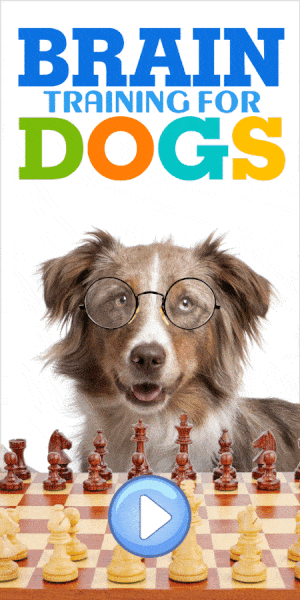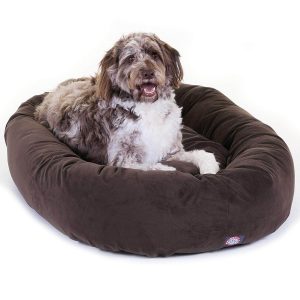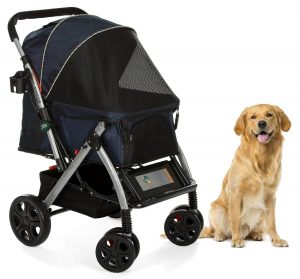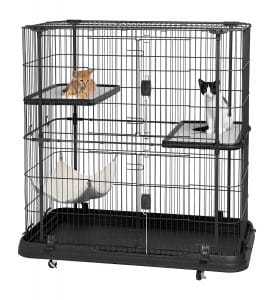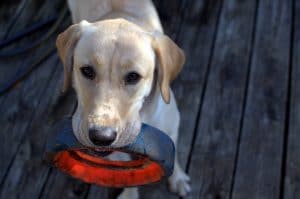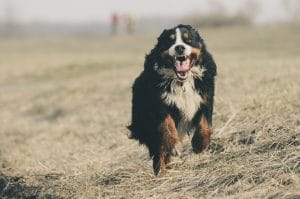Dogs and humans have one main problem that constantly works against them: they are of different species! As obvious as this seems, many dog owners tend to forget this fact. We expect our dogs to understand English; we expect them to differentiate between an expensive oak desk and a cheap chew toy. We fail to realize that to our dog, money has no meaning. The rug is nothing more than a comfortable place to urinate on and the desk you imported from Italy is extremely fun to chew on. Dogs are immoral; they do not bother themselves with good and bad. They deal with safe and dangerous, comfortable or not, and tasty or not. The sooner we understand this gap between the human specie and the canine specie, the sooner we will be able to accept them as they are and explain (in their language) our expectations from them. After all, we domesticated them, so it is our job to explain the rules and norms of living in a human society.
If you were to adopt a child from a far away culture; A child that does not understand the language, does not understand the value of money, and does not share the same cleanliness norms as you do, you would have taken the time to teach this child the language and the social norms in order for him to be able to live among you in harmony. Moreover, if you were to bring a new baby to the world, you would spend several years of patient explanations and teachings before she would become a responsible adult. You will repeat explanations over and over, you will reinforce good behaviors, you will protect the child from harm, and you will prevent the child from getting into trouble. Sounds familiar? It should be – your puppy is just like this new baby. It is clueless in regards to what you want from her. It is up to you to teach her the norms and prevent her from making mistakes or causing harm.
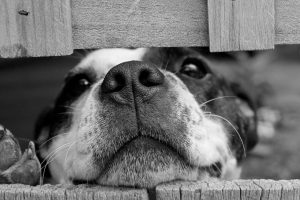
It is important to note that behavior is always changing. It can either change to the better or to the worse. Every unwanted behavior will tend to become worse unless we will interfere and modify it. if your puppy chews on your shoes and we will not prevent him from doing it, she will chew your shoes, socks, and boots the next time. Prevention, as discussed later, is an important cornerstone for puppy training. When we prevent our puppy experience unwanted behaviors, we allow her to grow up without the experience of enjoying those behaviors. As a result, we decrease the chances of developing bad habits in the future. While prevention helps us teach the dog what not to do, it is not enough. Combining prevention with an intense positive reinforcement program that teaches the dog what is allowed is a recipe for a stable, worry free dog.
What is Positive Reinforcement Training?
Positive reinforcement training is a method of teaching your dog which behaviors are beneficial for him. By rewarding wanted behaviors with things your dog loves (treats, toys…) we increase the likelihood of those behaviors to reoccur. The dog learns to associate certain behaviors with positive consequences and tends repeats those behaviors in order to access those positive consequences again. This training method avoids active punishment as a way of learning and instead chooses to ignore unwanted behaviors rather than punishing them. In general, every reinforced behavior will occur more often, and every ignored behavior will occur less often. For example, if your puppy jumps on people to greet them, we will ignore her while she is jumping and reward her (by playing with her, petting her, and giving her treats) when her four paws are on the ground. As long as you are consistent, your puppy will stand or sit when she sees people. Try to remember that the dog has no interest in doing one behavior over the other. The dog engages in behaviors that bring rewards. If your dog is jumping, it is probably due to a history of reinforcing this behavior. Once you stop reinforcing jumping, and start reinforcing sitting, the sitting behavior will take the place of the jumping behavior.
Why use positive reinforcement training?
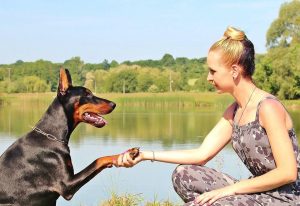
Basically – because it works! The theory behind the systems was researched dozens of years ago by scientists like Pavlov and Skinner. One of the best examples that the system really works is training marine mammals such as dolphins and killer whales in various locations in the world. The amazing shows you see at places like “Sea World” are the result of positive reinforcement training. in this case, a certain behavior (i.e. a summersault in the middle of the pool) is rewarded by several fish. One cannot punish a dolphin – it swims away. In the case of a killer whale, trying to punish it may result in serious injuries to the trainer – wild animals do not necessarily respond well to pain. The precision the trainers get from the animals is a great example for the efficiency and success of positive reinforcement.
In addition, positive reinforcement training is simpler compared to punitive methods and can cause no harm to the animal. Training that involves various active punishment methods requires much more experience and knowledge. Using punitive methods without the required behavioral knowledge can cause great emotional harm to the dog and in the long run (and sometimes in the short run as well) can destroy the relationship between owner and dog. in contrast, the worst possible damage you can cause while working with positive methods is the strengthening of an unwanted behavior – Damage that can be easily fixed in the next training session or even the next repetition.
Most importantly, positive reinforcement training is fun for both owner and dog. The dog learns to enjoy new behaviors and the owner gets to see great improvement without the need to act with force and punishment.
My dog did that to me for spite
As humans we try to understand other animals by anthropomorphizing (ascribing human characteristics to a non-human) and comparing them to us. It is fairly natural that we would do that. After all, we know our specie better than any other. However, anthropomorphizing can be the source of many misunderstandings between dog and owner. These misunderstandings can cause the owner to act in a manner that is detrimental to the relationship with the dog.

“My dog peed on my bed to get back at me for leaving home alone” is a common sentence among dog owners. Other common phrases include “my dog is barking all day even though she knows she should be quiet” and “my dog is stealing food from the kitchen counter only to see me get angry”. Getting back at someone, distinguishing between good and bad, having a moral conscience, are all characteristics of humans yet have nothing to do with our dogs. Our dogs do not have getting back at the owner on their agenda; they simply don’t do that.
the sooner one realizes that dogs do not and cannot do anything for spite, the sooner one is able to stop punishing his/her dog since, after all, why punish someone if this has nothing but pure intentions.
Dogs learn by association. They “try out” the world and see what happens. All they think about is how their actions can benefit them at the moment of engaging in those actions. Here are a few examples of how dogs may think: I get on the counter, there’s food on the counter, I eat the food and I like it – I will do it again in the future. In contrast: I get on the counter – there is never anything there, I will stop getting on the counter. I am left alone and I’m stressed, I go to my owner’s bedroom, his socks have his smell and it relaxes me – I chew on the socks. In contrast: my owner leaves me alone, I have no access to my owners’ bedroom, only to my room which has toy stuffed with peanut butter and roast beef – I chew on that toy.

The less you spend time trying to figure out why your dog is doing something, and the more you concentrate on the dog’s action and how you can modify them, the more successful you will be in communicating with your dog. It is also important to note that dogs cannot learn after the fact. Once a behavior is over, we cannot reinforce it or punish it. If you want to reinforce your dog (or punish your dog) you have to do it when the action is taking place. When one comes home, sees a puddle of urine and punishes the dog, he/she does not teach the dog anything except that they are dangerous when they come home and they have this certain look on their faces. The dog simply cannot make the connection between a certain consequence that happens 5 seconds, 2 minutes, or an hour after the action that supposedly caused it.
Remember, despite what you might think, and despite what you have been told in the past, your dog does not do anything to get back at you. The reasons for the dog’s actions are much simpler than the complex thinking patterns we ascribe them. There are no ulterior motives and no mysterious conspiracies; if the dog acts in a certain way, it is because she thinks it will benefit her. It is our job to teach her what benefits her and what does not benefit her.
I require total compliance and success
I often hear dog owners say that they want their dogs to obey them all the time and without exception. However, this demand is unrealistic and practically impossible. Think of it this way: we all make mistakes, we all fail, and we all lack concentration from time to time. The best shortstop in baseball commits several errors in a season. The best chef makes dishes that aren’t very tasty from time to time, and the best driver fails to notice the stop sign a few times in his/her lifetime. If humans, creatures with much greater brain power compared to dogs, fail sometimes, why do we expect our dogs to be always perfect? A success rate of 80-90% is much more realistic, especially when we train family dogs for general obedience.

It is interesting to note that although we constantly anthropomorphize dogs when it is convenient for us (we claim they know to distinguish between good and bad and that they are getting back at us), we fail to anthropomorphize when it acts against us. We know that even humans cannot achieve perfection yet we ask our dogs for it. An understanding of the fact that there will never be perfection and total compliance can help us avoid getting angry at our dogs when we say “sit” yet nothing happens.
In addition, many dog owners require total compliance without rewarding the dog. in other words, the dog needs to comply because I am his master and not because it is beneficial to her. Try to think of the last time you obeyed or complied with your boss’s order without getting a reward for it. You work for a paycheck and if it wasn’t for the paycheck you would not have done anything. Just like a good word from your boss is not enough for you to work, so is petting your dog and saying “good boy” is not enough to have him comply with your cues. The dog needs to know that he will receive a salary – whether it is a toy, food, or anything else of interest to him.
Think of all those rewards as your dog’s salary for doing a good job for you. He is a living organism that is free to make his/her own choices. When he/she chooses to comply with your cue – be benevolent and reward it. You should also try and think of your commands as cues or requests. Building a relationship based on compliance due to free will rather than one based on fear and compulsion is much more rewarding for both owner and dog.
Prevention and management – the cornerstone of raising a puppy
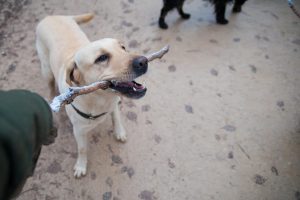
Prevention is a method of helping the dog to succeed. By not letting the puppy get into situations in which he is bound to fail we set the puppy up for success. The goal of prevention is to stop the dog from committing errors such as urinating in the wrong place, chewing improper objects, etc…
Prevention, it seems, is many times forgotten among dog owners. We expect our puppies to avoid searching for food in the garbage can yet we leave it open; we don’t want him to get on the bed yet we leave the bedroom door open. Many behavior problems such as those described above are so easily solved with the blocking of access to possible problem areas.
Humans constantly use prevention in their daily lives with much success. We prevent babies from being electrocuted by installing safety outlets. We prevent them from putting dangerous objects in their mouths by putting picking all those objects up and putting the baby in a cradle we cannot supervise him/her. We prevent robbers from entering our houses by locking the door and installing an alarm system. We prevent a slugger from hitting a home run by intentionally walking him. The list goes on and on and we humans seem to have a good grasp on the advantages of prevention. Nevertheless, many times we fail to use those same methods with our dogs. We tend to leave them unsupervised in the house for hours and expect them to leave everything in order. We wouldn’t expect it from our babies, humans with greater brain capacity, yet we think our dogs are super creatures that read our minds and know what we want from them. It is hard to tell where those expectations arose from, but regardless they are unrealistic. If you do not want your dog to pee on your bed, start by closing the bedroom door – I guarantee it will work.
Hmmm, Food
If we want to succeed with positive reinforcement training, we need to make sure that the rewards we use actually reinforce the dog. A reinforcer is anything that happens right after a certain behavior and increases the chances of that behavior to reoccur. Whether we think a certain reward should be reinforcing has no meaning, it is the dog that needs to absolutely love the reward so the chances of a behavior to reoccur increase.
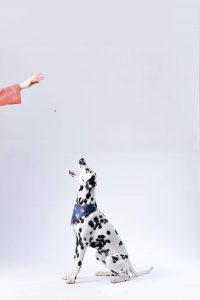
For many dogs, food is a great reinforcer. The need for food is very primal and very tasty food can get your dog to go along way in order to get it. Your dog’s dry food can be reinforcing to some extent. It can be enough in order to get your dog to sit in a quiet environment. However, it may not be enough to get your dog to heel in a noisy and interesting environment. The food rewards you give your dog should be more interesting than the environment. Every different environment may include dozens of reinforcers for your dog: sniffing other dog’s urine, chasing a cat, greeting a person on the street, etc…all those are intrinsic reinforcers. It is our job to make sure that what we have to offer is much better than anything else. Sometimes, this can be difficult to achieve. Several ways of doing that are described in later chapters. The food rewards we use should be of a large variety. We should also be generous with the amount we give, especially in the beginning of the training. the higher the salary of the dog (quality and quantity of food) the more the dog will want to work.
From my experience, the best food rewards are different meats. Chicken, roast beef, turkey, lamb, and every other meat you can think about are usually good. Dogs are meat eaters, their diets rely mostly on protein and it is inherent in their nature to really want foods that contain protein. You need to make sure that the meats you give are not overly spiced. This may cause some digestion problems. In addition, when you train with food, you want to make sure that you take into consideration the amount of food used for training when you calculate the total food intake of your dog. Simply put, if you train extensively with food, cut down on the quantities in the regular meals of your dog (this is especially true for breeds that tend over eat and become overweight).
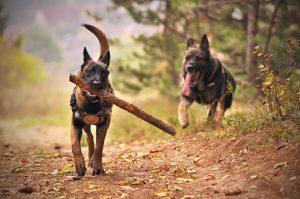
Food, however, is not the only reinforcer you can use with your dog. Many dogs will work for a game of chase, for a game of tug, or for catching a flying disc. Some dogs will work for praise and petting although from my experience those are rarely enough. You should try different types of foods and toys to find out what really gets your dog going. You will know what works when you see the spark in your dog eyes that says “ok, what do I have to do to get that piece of roast beef”. Make a list of all the things that your dog really loves and use it for training your dog. You can use the table in appendix A in order to remember all those great reinforcers.


